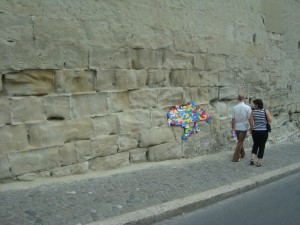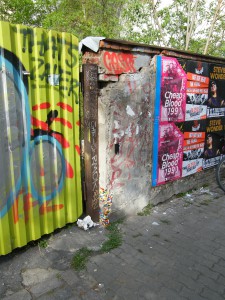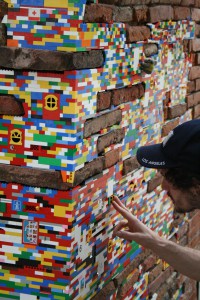JAN VORMANN (DE): DISPATCHWORK
26.9. ● 18:00 – 04:00 ● Streets of Zagreb ● Nuit Blanche*
Dispatchwork aims to patch holes in broken walls worldwide, completing the material compilation in urban constructing and adding color to the urban greyscale by inserting a very basic construction material: Plastic Construction Bricks (PCBs), the most famous example of which are – lego bricks! Adapting to various cities, the project infiltrates walls of cultural heritage, historic facades, fortifications and yet many more less spectacular corners.
One of the main aspects of the project is the invitation to all the people worldwide to join in the project. By collecting the images for non-commercial purposes on the project website (www.dispatchwork.info), Jan is trying to create a transnational network of people assuming a collective culture.
www.janvormann.com / www.dispatchwork.info
INTERVIEW
HOW WOULD YOU DESCRIBE YOUR „DISPATCHWORK“ TO A RANDOM PASSER-BY?
I don’t enjoy living in dull and grey cities. Do you? Have you noticed that toys for kids are generally very shiny and colorful? I wonder why that is, given that they are to be brought up to live in mostly dull and gray cities as adults. Since I lived in many of such cities, I am seeking to improve the appearance of public spaces in different ways, in terms of what I consider improvement.
Dispatchwork aims to seal fissures in broken walls worldwide, completing the material compilation in urban constructing and adding color to the urban greyscales, by inserting a very basic construction-material:Plastic Construction Bricks (PCBs). In fact, PCBs are one of the first material with which we conceive architecture. PCBs are solid and stiff and shape up perfectly rectangular yet, concerning the essential structure, they contradict the purpose, given that the repair is just so very temporary, with the patches crumbling out of the walls in a matter of no time, being taken or washed away.
Dispatchwork does not defy deterioration. Rather, it aims to emphasize transitoriness as a chance for the construction and reconstruction of our environments. Adapting to various cities, the project infiltrates walls of cultural heritage, historic facades, fortifications and yet many more less spectacular corners as a colorful repair of shabby walls within our shared spaces.
Dispatchwork contradicts and satirizes the superimposed seriousness of constructions in the cityscape. Within all that rigidity and stiffness there are plenty of chances for your own creativity. The project also aims to put the focus on the playful, hands-on aspects of creation in our daily lives, and further, on the possibilities for participation to construe and design our own reality.
WHY DID YOU CHOOSE THIS FORM TO TALK ABOUT REALITY?
Generally, I use the form of sculpture to talk about reality because I feel like I can express myself more directly using three-dimensional materials, meaning everyday objects that make up our daily lives.
It’s plain for us to see that our world is made up of objects that we can use and manipulate, but they also influence us and our mood. The „voice“ of any material, its specific language, including all associations it may evoke taking into account individual human experience, can be heard and used like musical notes or words to make up „sentences“ that can describe situations which would be otherwise undescribable.
Dispatchwork uses precisely a material that almost anyone can relate to: plastic construction bricks! The joyful feeling that we get when we see the material is carried almost through all cultures and ages, from what I can say in my own experience. Just like soapbubbles, another material that I like to work with, these „toys“ have the power to evoke ludic thoughts. One main part of the project is to include anyone who wants to join worldwide in a non-commercial way: anybody and everybody can join the project anywhere in the world to add to the patchwork of contemporary city-scapes. I collect the images on the project-site www.dispatchwork.info and in this way I’m trying to create a transnational network of people assuming a collective culture. Besides reflections on architecture and street art that this project brings along, the actionism of loosely organised groups and people worldwide is another larger aspect of what I wanted the project to develop into. When taking part in Dispatchwork, it is therefore not only about the local repairs of fissures in walls, but also a lot about being part of a bigger network uniting citizens of the world via the internet.
WHY SHOULD WE, AS AUDIENCE, CARE ABOUT WHAT YOU’RE DOING?
I assume that you, as audience, obviously DO care about what we (artists) are doing, else would there be festivals, exhibitions, or even an art-market? Therefore, in my eyes, this question is more interesting: why do you care about what we are doing? What does it give you, when you look at art? Could you imagine a world without it?
IF YOU HAD ANY MEANS AVAILABLE (‘IDEAL WORLD SITUATION’) WHAT KIND OF PROJECT WOULD YOU DO?
Tearing down the concept of „the nation“ and erradicating all physical borders that hinder the free flow of peaceful world citizens.
WHAT THREE THINGS NEVER FAIL TO BRING YOU PLEASURE?
- Working on my projects
- travelling the world
- Kids
BIOGRAPHY
Jan Vormann finished Visual Arts (sculpture) in Kunsthochschule Berlin-Weißensee (KHB). He takes part in transnational and interregional exhibitions, art fairs and galleries and teaches at the Berliner Technische Kunsthochschule (BTK).
Projekt se realizira uz potporu Goethe-Instituta u Hrvatskoj te je dio programa Edukulture Kulture promjene Studentskog centra u Zagrebu.
*Događanje organizirano u okviru manifestacije Rendez-vous, festival Francuske u Hrvatskoj (www.rendez-vous.hr).






